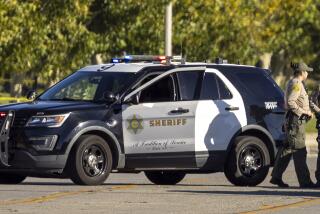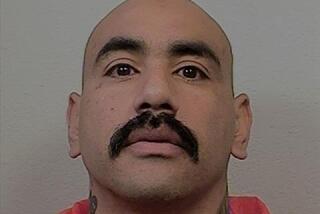Pair Ambush, Kill Gangs Counselor : Violence: Police call the slaying an execution after the woman is gunned down in the driveway of her home. One suspect, who was recently released from prison, is arrested.
- Share via
A Boyle Heights woman who had dedicated her life to counseling youths away from gangs and served as a technical adviser on the Latino gang film “American Me” was gunned down execution-style in her driveway by two masked men, police said Thursday.
Ana Lizarraga, 49, grew up tough in the Ramona Gardens housing project and spent the last 10 years as one of the top counselors with Community Youth Gang Services. She was fatally shot by gunmen from less than 10 feet away as she packed her van in preparation for a trip to Utah to attend her mother’s funeral.
An officer in a passing patrol car witnessed the shooting and called for backup. Within minutes, police arrested one suspect, Jose Gilbert Gonzalez, 29, who had been released from prison last month. The other suspect, who has not been identified, fled and had not been arrested as of late Thursday.
“This is an execution,” Police Detective Robert Suter said. “Somebody lies in wait, they don’t say a thing and then fill you full of bullets.”
A State Department of Corrections official said that Gonzalez was a member of the Hazard Street gang, an East Los Angeles gang whose members Lizarraga had counseled. Gonzalez has Hazard tattoos all over his body, said Jerry Dimaggio, the department’s regional parole administrator.
Gonzalez, who was booked on suspicion of murder, was released from Folsom prison on April 27 after serving almost two years on a weapons possession charges, Dimaggio said.
Los Angeles police released no further details about the shooting and would not say whether it was related to her gang work.
One detective at the scene said there is no motive and that Lizarraga had not reported receiving any threats.
Suter would not comment as to whether her advisory role and small part in the film “American Me”--which chronicles the violent rise of the Mexican Mafia and Latino prison gangs--was related to her death. The film, which starred and was directed by Edward James Olmos, sought to strip away glorified illusions about prison and street gangs, Olmos has said. Olmos portrayed a Mexican Mafia leader in Folsom prison.
Police said Lizarraga’s killing was the second murder of someone associated with the film. They said another technical adviser, Charles Manriquez, who was a reputed member of the Mexican Mafia, was shot to death March 25 at the Ramona Gardens housing project, about a quarter of a mile from the Lizarraga home.
However, spokespersons for Olmos denied that Manriquez, also known as Charlie Brown, was involved with the film.
“He did not work on ‘American Me,’ ” said Fernando Cubillas, Olmos’ assistant. “In the beginning when Eddie was doing research, he talked to hundreds of people, and Charlie Brown was one of them. But that was two years before filming even started. He was not a member of the technical crew and he was not on the film.”
Gonzalez was being held at the Parker Center Jail on Thursday without bail. He had been arrested in 1982 for attempted murder after firing a shotgun into a crowded party, Dimaggio said. No one was hit during the shooting. But Gonzalez was convicted of assault with a deadly weapon and sentenced to a six-year term. He entered prison on Aug. 19, 1983, and was paroled in 1986.
Lizarraga’s boyfriend was outside helping her pack the van when shooting erupted, but he was not hit. The men, who had stockings pulled over their faces, apparently had been hiding in a park across the street from her home.
Several of her children and neighbors were at a loss Thursday to explain the killing.
Manuel Lizarraga, 30, her eldest son, said: “There no reason for this. She had no enemies. She was well-respected by gangs. She could go into any neighborhood. Everyone in this neighborhood knows her.”
Manuel Lizarraga said he was inside his mother’s brown stucco house in the 2400 block of Lancaster Avenue shortly before 11 p.m. Wednesday when he heard the barrage of gunfire and ran outside.
“You know we hear shooting around here regularly,” he said. “But when you run outside and you look and you see that it’s your mother, it’s a nightmare that I hope nobody ever has to go through.”
Lizarraga’s six children and countless friends and co-workers poured into her house Thursday, shocked by the death of their friend, nicknamed “the Gang Lady” by neighborhood youths.
Detectives had marked chalk circles around at least five places on the driveway and sidewalk where bullet casings had landed. Bloodstains marred the asphalt.
“She was like a mother to me. She helped me get a job,” said Norma Escarcga, 35, who visited the family. “She was my role model. I stayed in school because of her.”
At the Romona Gardens project, a cluster of youths sat outside the gym, angry and saddened over the death of the neighbor they had known for years.
“She was like family to everyone here,” said one 22-year-old man. “She was always telling us to be careful. When she saw us out late she would yell at us to go home.”
Steve D. Valdivia, executive director of Community Youth Gang Services, said Lizarraga was a 10-year employee and one of the organization’s “top community workers who dedicated her life to improving the quality of life of others and the pursuit of peace among gangs.”
He emphasized that the agency is not an arm of law enforcement or the justice system. Employees work directly with youths and their families by cruising the streets, making contact with gangs and responding to scenes of gang tension to help cool anger.
Lizarraga, who once described herself as a “veterano” gang member, said in a 1984 interview with The Times that she felt a special obligation to work with youths after she lost her husband and two nephews to gang shootings. She said she wanted to be a model for her own children so they would not become gang members.
Her job included patrolling--unarmed and often alone--the Eastside neighborhood turf of 52 gangs.
“They don’t bother me,” she said of gang members who watched her drive through their territory offering street-smart words of advice and greetings. “The gang members have told me that they think we must be crazy for driving in there, so they just leave us alone. The police don’t understand how I can be so brave, but it’s just something I do.”
More to Read
Sign up for Essential California
The most important California stories and recommendations in your inbox every morning.
You may occasionally receive promotional content from the Los Angeles Times.










